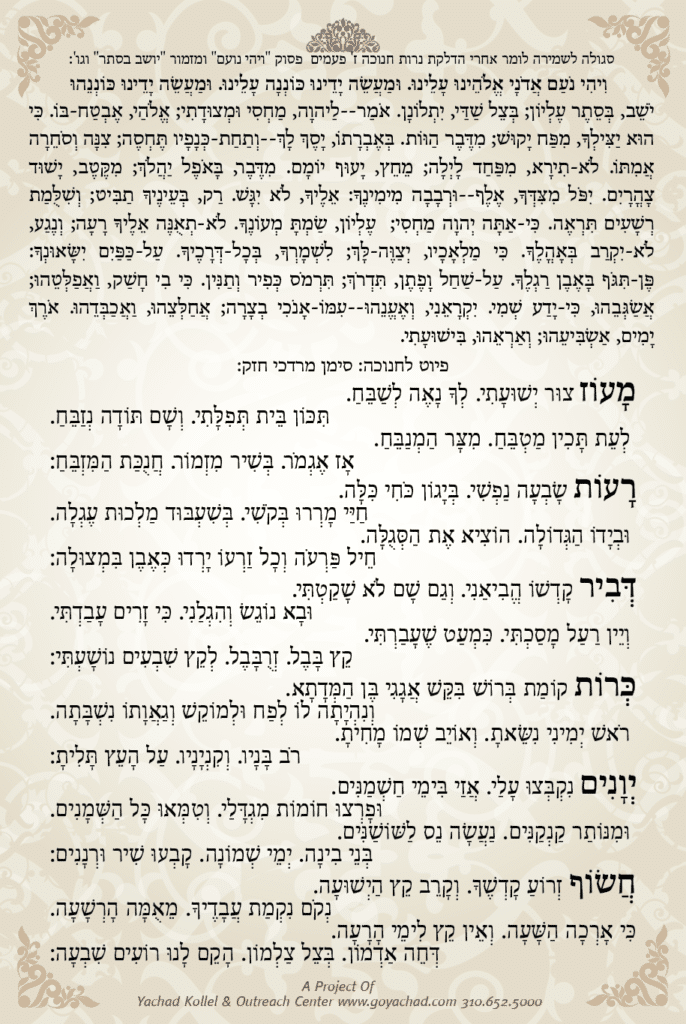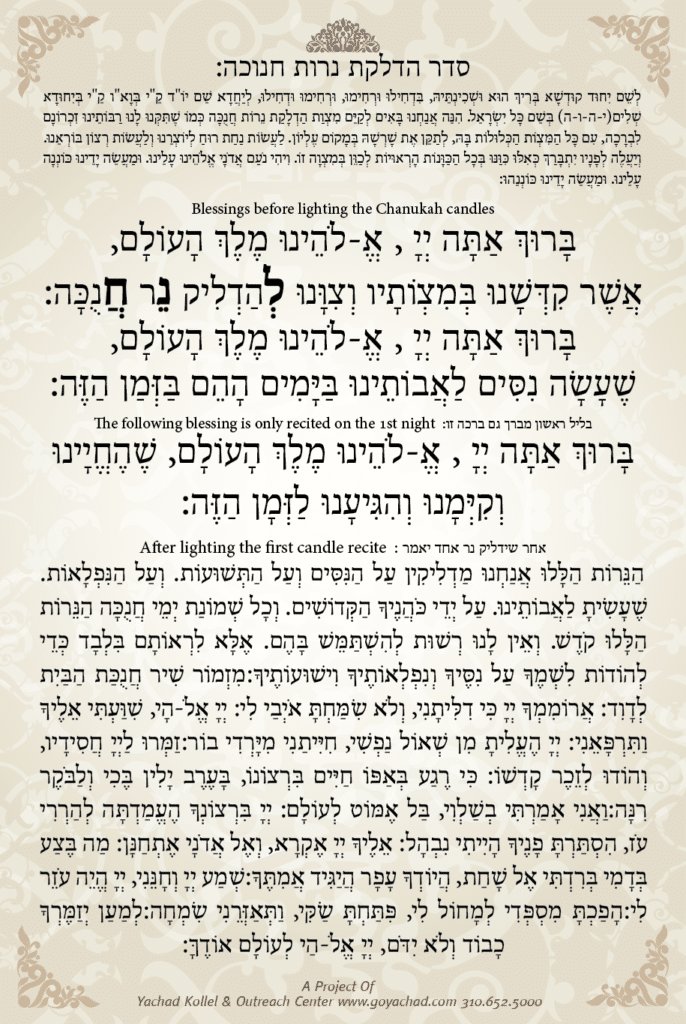 |  |
The Laws & Customs of Chanukah
- Chanukah begins on the evening of the 25th of Kislev and continues for eight days. ( This year (2015) first night of Chanukah is on Sun night, 6th of Dec)
- For the entire eight days of Chanukah it is forbidden to fast or to eulogize.
- It is permitted to work; however it is customary for women not to work for at least the first half hour of the candles’ burning, and some have the custom not to work for the entire time of burning. The types of activities that are forbidden are things like sewing and laundry etc. (Cooking is permitted.)
- There is no obligation to have festive meals; however it is customary to celebrate by eating special meals anyway, because of the fact that the dedication of the Temple and Altar took place during Chanukah.
- It is customary to sing during the meals songs that thank and praise Hashem. To sing and speak about Torah makes the meal into a Seudat Mitzvah, a meal of religious significance.
- It is customary to eat milk foods because Yehudit, daughter of Yochanan the High Priest, was taken to be defiled by the Greek ruler Holofernes. She fed him cheese (to make him thirsty) and wine (to quench his thirst); and after getting him drunk she killed him. This was one of the events that sparked the Maccabean uprising. Food fried in oil is also eaten to commemorate the miracle of the Menorah. Latkes and donuts are the most common foods.
- One should not fast during Chanukah, even on the occasion of a parent’s yarhzeit(anniversary of death).
- The festivities of Chanukah should be combined with study of Torah.
- It is obligatory to light candles, and one should even borrow money to fulfill this mitzvah. If a poor person needs money for Chanukah candles the community is obligated to provide for him.
- The minimum obligation is that every household should have one candle burning every night. It is customary to be scrupulous regarding this mitzvah: to have one candle on the first night and add an additional candle every night (1-8) for the household (Sephardic), Ashkenazim have the custom that everyone in the house lights a personal
- Any type of oil is acceptable for use in the menorah, however, it is best to use olive oil. The oil should not be made of a forbidden substance, nor should it be something from which it is forbidden to derive benefit.
- The menorah should be similar to the Menorah in the Temple and hence most authorities forbid using electric lights or gas lamps.
- The light should be clear, and the wicks should not flicker
- Wax candles are also acceptable, providing they have a single wick.
- All wicks are acceptable, but it is best to use cotton. The same wicks may be used over and over again.
- It is correct to have a Menorah of glass or metal if one is lighting with oil, since other substances such as clay become disgusting after one use. If one can afford it, it is correct to buy a beautiful Menorah.
- If one is using candles a Menorah is not necessary.
- If a number of people are lighting in one household they should make a slight separation between their menorahsso that there is no confusion to the observer as to the number of candles.
- Ideally, the Menorah should be placed outside the house to the left of the entrance. Since anti-Semitism was so common throughout Jewish history it became customary among many communities to place the Menorah inside the house, near the entrance or on the table. In many families it is the custom to place the menorah in a window facing the public, especially where many people share one entrance (e.g., apartment building). In Israel it is customary among some communities to light outside in a special box that prevents the flames from blowing out.
- Students (Yeshiva, Seminary…) who don’t live at home should consult a Rabbi on how to perform the mitzvah of lighting Chanukah lights. (Lighting in the dormitories is usually a fire hazard and should therefore be avoided)
- The menorah should be no lower than three tfachimfrom the floor (approx. 10.5 inches or 27cm) and should be no higher than 20 amot from ground level (35.5 ft or 10.8 m). Ideally, it should be about 10 tfachim high (35 inches or 90 cm).
- The Menorah should have all the candle or wicks on the same level, none higher or lower than the others.
- It is customary to have an additional candle (the shamash)with which to light the other candles and in order to use its light. The shamash should be placed in a way that shows that it is not one of the Chanukah candles.
- It is forbidden to derive benefit from the light of the Menorah just as it was forbidden to derive benefit from the Menorah in the Temple, and also in order to show that its purpose of the Menorah is for a Mitzvah, not just for illumination.
- It is preferable to have the candles in a straight line, and not in a semi-circle, however it is permitted to have them in a semi-circle providing each candle is clearly separated from the others.
- It is prohibited to light the shamash from the Chanukah candles.
- Left over wicks and oils should be destroyed after Chanukah (except for unused oil left in bottle) since they may not be used for anything else.
- There are different customs as to the lighting of the Menorah, Ideally a person should follow the custom of his father. Sephardic custom is light the candles after praying Arvit , at the onset of night when the stars become visible, about 20-30 minutes after sunset (Set-Hakochavim).
- It is obligatory to put in enough oil, or a long enough candle to burn for at least 1/2 hour after nightfall (i.e. the appearance of three medium size stars).
- In exceptional circumstances one may light one and a quarter hours before sunset without a blessing. (However one should be careful to put in more oil or to use longer candles). If possible it is better to appoint an agent to light candles at the correct time, than to light early. .
- If one forgot or was not able to light at the correct time, one may light as long as people are still awake in the house in which one is lighting.
- One should prepare the wicks and candles etc. before Arvit or well before the time of lighting in order to light the Menorah at the correct time.
- It is best to light in the presence of many people in order to publicize the miracle.
- On the first night three brachot, blessings are recited. “Lehadlik ner Chanukah”, “She asa nissim” and “Shehecheyanu”..
- On the other nights only the first two blessings are said.
- All the blessings should be recited before actually lighting the candles. First light the Shamash before the blessings to avoid delay. It is forbidden to speak between the recitation of the blessings and the completion of candle lighting.
- “Haneirot Halalu” is recited either during or after the lighting of the additional candles.
- Some sing “Maoz Sur Yeshuaty”after lighting.
- Place first candle on the extreme right of the Menorah. On the second night add a candle on the left. Light the newest candle first and proceed to the right.
- Do not remove the Shamash from the wick until the flame catches on most of the wick.
- One does not add candles if they forgot to light on any night…
- The Menorahshould not be moved after is has been lit.
- If the Menorahwas lit in accordance with the requirements of Jewish law and it was extinguished, one is not obligated to relight it, but one may relight it without reciting a blessing.
- If the Menorahwas not lit properly in the first place, or was lit in a windy place and blew out then one is obligated to relight if it went out within 1/2 hour after nightfall.
- On Friday afternoon, the Chanukah candles should be lit beforethe Shabbat candle-lighting time (if one accepted Shabbat and did not light Chanukah candles it is forbidden to light Chanukah candles).
- On Friday Minchashould be said before lighting, if possible.
- Remember to put in more oil or bigger candles on Friday, so that they burn 1/2 hour after nightfall. Try to light just before the Shabbat candles, (without of course delaying the lighting of the Shabbat candles)
- After Shabbat one should first recite Havdalah, then light the Chanukah candles. One may not use the Menorahas the candle for Havdalah.
- If one is a guest at someone’s house (and staying there for the night), one should give the owner a small amount of money to buy a portion in their candles and one may fulfil the obligation through the owner.
- If one is eating out then one should light the Menorahat their place of residence.
- During morning prayers, Shacharit, one should recite the full Hallelevery day.
- “Al hanissim” the special paragraph of prayers for Chanukah is added in the silent prayers, Shmoneh Esreh and also in Grace after meals. If one forgot to say this addition, one should not repeat either Shmoneh Esreh or Grace.
- It is customary to light a Menorahin the Synagogue every evening. It is placed at the southern wall of the Synagogue, in imitation of the Menorah in the Temple in Jerusalem.
By Rabbi Mordechai Becher
Revised by Rabbi Shemuel Akhamzadeh
